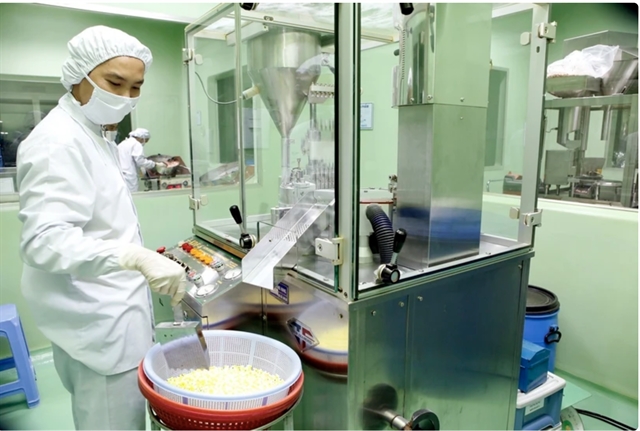 Society
Society

 |
| Drug production in a Vietnamese pharmaceutical company. VNA/VNS Photo |
HÀ NỘI – Việt Nam is focusing on improving research capacity and application of new drug production technology, promoting clinical pharmacy development and strengthening supervision of safe and reasonable drug use, aiming to become a centre for new science and medical innovation in the region.
It is really a long journey.
To realise the target, the country must make changes and breakthroughs to quickly approach the world's development achievements.
Currently, application of advanced technologies such as artificial intelligence (AI), data analysis, virtual reality, blockchain and robotics to health care service have helped save time and cut costs for patients.
The country has set up a National Strategy for Developing the Pharmaceutical Industry to 2023 and vision to 2045 which focuses on improving the research capacity and application of available technology to produce generic drugs and new dosage forms aiming to become a production and processing centre receiving technology transfer of original brand-name drugs from the ASEAN (Association of South East Asian Nations) region.
Accordingly, Việt Nam strives to develop the domestic pharmaceutical industry to level 4, the highest level according to the classification of the World Health Organization.
By 2030, 100 per cent of drugs will be provided proactively and promptly for disease prevention and treatment needs, to ensure drug security and meet the requirements of national defence, security, pandemic prevention and control, consequences of natural disasters and public health incident recovery, and other urgent drug needs.
Domestically produced drugs strive to meet about 80 per cent of demand and 70 per cent of market value, as well as continue to achieve the goal of producing 20 per cent of raw material needs for domestic drug production.
Regarding clinical trials and opportunities to access new drugs and treatment methods, Dr. Đào Văn Tú, director of the Clinical Trial Centre of Hà Nội’s Cancer (K) Hospital, said that clinical trials play an important role in applying research results.
About 5-6 years ago, many patients and even doctors thought that those participating in clinical trials were "lab mice", but nowadays these thoughts have changed, said Tú.
Reality has shown that in Việt Nam, clinical trials are currently only conducted with products qualified for use on humans, not dangerous research, the doctor said.
People participating in clinical research projects have the opportunity to access new treatment methods and in fact, there have been cancer patients who have been cured while participating in research projects, he said.
According to the doctor, clinical trial research in cancer treatment is increasing rapidly in many countries, but in Việt Nam there are still some limitations.
The rate of patients participating in clinical trials in Việt Nam is currently only 1-2 per cent, while in other countries, this rate is at least 10 per cent.
The reason is that domestic units still lack human resources to carry out clinical trial research.
In addition, slow processing of approving clinical trial research is one reason hindering the research expansion.
Goal of producing original brand-name and new drugs
Dr. Tạ Mạnh Hùng, deputy director of the Drug Administration of Việt Nam (Ministry of Health), said that previously the average annual medicine cost per capita for a Vietnamese person was less than US$5, but now it has increased to $70 and the domestic pharmaceutical industry has basically met the drug demand.
Việt Nam is considered one of the countries with the lowest rate of counterfeit drugs in the region, Hùng said.
In recent years, sub-standard drugs have been maintained at a low level of less than 2 per cent of the total number of samples taken on the market, as compared to over 10 per cent in the 1990s, he said.
Regarding production, Việt Nam has developed a large number of pharmaceutical enterprises. However, domestically produced drugs are not highly competitive.
More than 200 enterprises mainly produce generic drugs. There are more than 800 pharmaceutical substances circulating in the domestic market, but the number of pharmaceutical substances produced by domestic enterprises is less than 50 per cent.
"At present, nearly 90 per cent of raw materials for drug production are imported. The proportion of drugs assessed as bio-equivalent is low, only about 10 per cent,” Hùng said.
“Therefore, one of the goals of developing the pharmaceutical industry in the near future is to partially shift from producing generic drugs to patent drugs,” he said.
He also recommended some solutions to realise the targets of developing the pharmaceutical industry, including improvement of institutions and laws on drug production, business, import-export, supply and distribution, especially offering the highest incentives to research and transfer technology to produce innovative drugs, vaccines and biological products.
It is necessary to plan, arrange and reserve land funds for the development of drug research and production facilities, as well as plan for growing areas, exploitation and processing areas of medicinal herbs in the country.
In addition, the State management agencies have to improve management capacity and control the market of drugs and medicinal ingredients, especially testing vaccines and biological products.
It is essential to promote research and international co-operation to develop generic and specialised drugs, as well as set up roadmaps to standardise basic and advanced training activities for the pharmaceutical workforce, he added. VNS